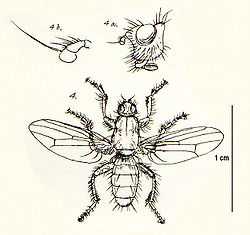Coelopa frigida
| Coelopa frigida | |
|---|---|
 | |
| Scientific classification | |
| Kingdom: | Animalia |
| Phylum: | Arthropoda |
| Class: | Insecta |
| Order: | Diptera |
| Family: | Coelopidae |
| Genus: | Coelopa |
| Species: | C. frigida |
| Binomial name | |
| Coelopa frigida (Fabricius, 1805) | |
Coelopa frigida is a species of seaweed fly or kelp fly. It is the most widely distributed species of seaweed fly.[1] It can be found on most shorelines in the temperate Northern Hemisphere.[1] Other species of seaweed flies include Coelopa pilipes.[2]
The fly has a grayish black body and yellow-brown legs.[1]
The fly oviposits in dead kelp that washes up on beaches.[3] This is the only place it lays eggs, and it can do so on many species of kelp and seaweed,[4] including species of Laminaria and Fucus.[5] A female fly lays up to five clutches of 80 eggs each.[6] The larvae feed upon the bacteria coating the dead kelp.[4] The life cycle is about 11[1] or 12[6] days long.
"Blooms" of the flies occur at times, possibly when temperatures and amounts of kelp increase.[3]
This fly is sometimes cultured in the laboratory.[6] Its behavior is studied in an effort to understand sexual selection, especially the topic of female choice.[7] Studies suggest that female flies of this species prefer larger males to smaller.[8][9] The species engages in sexual conflict.[10] Females perform rejection behaviors when mounted by males, and may mate with larger males because larger males are better able to force the mating.[10] As females are more likely to successfully reject smaller males, sexual selection favors larger ones.[10] Mating behaviors are genetically influenced, as evidenced by a preference for smaller males among females of a certain genotype.[11]
This fly is host to the mite Thinoseius fucicola.[2] It provides food for seabirds such as the purple sandpiper (Calidris maritima).[12] It competes with another seaweed fly, C. pilipes, for resources.[5]
References
- ↑ 1.0 1.1 1.2 1.3 "Kelp Fly". Marine Wildlife Encyclopedia. Oceana.
- ↑ 2.0 2.1 Gilburn, AS; Stewart, KM; Edward, DA (2009). "Sex-biased phoretic mite load on two seaweed flies: Coelopa frigida and Coelopa pilipes". Environmental entomology 38 (6): 1608–12. doi:10.1603/022.038.0612. PMID 20021755.
- ↑ 3.0 3.1 Mather, Kate (June 18, 2011). "South Bay beaches hit by swarms of kelp flies". Los Angeles Times. Retrieved June 18, 2011.
- ↑ 4.0 4.1 Cullen, Sally J.; Young, Alison M.; Day, Thomas H. (1987). "Dietary requirements of seaweed flies (Coelopa frigida)". Estuarine, Coastal and Shelf Science 24 (5): 701. doi:10.1016/0272-7714(87)90108-9.
- ↑ 5.0 5.1 Edward, Dominic A.; Newton, Jason; Gilburn, André S. (2008). "Investigating dietary preferences in two competing dipterans, Coelopa frigida and Coelopa pilipes, using stable isotope ratios of carbon and nitrogen". Entomologia Experimentalis et Applicata 127 (3): 169. doi:10.1111/j.1570-7458.2008.00692.x.
- ↑ 6.0 6.1 6.2 Burnet, B.; Thompson, U. (2009). "Laboratory Culture of Coelopa Frigida (Fabricius) (Diptera: Coelopldae)". Proceedings of the Royal Entomological Society of London. Series A, General Entomology 35 (4–6): 85. doi:10.1111/j.1365-3032.1960.tb00672.x.
- ↑ MacDonald, C.; Brookfield, J. F. Y. (2002). "Intraspecific molecular variation in the seaweed fly Coelopa frigida consistent with behavioural distinctness of British and Swedish populations". Molecular Ecology 11 (9): 1637–46. doi:10.1046/j.1365-294X.2002.01559.x. PMID 12207715.
- ↑ Gilburn, A S; Foster, S P; Day, T H (1992). "Female mating preference for large size in Coelopa frigida (seaweed fly)". Heredity 69 (3): 209. doi:10.1038/hdy.1992.118.
- ↑ Gilburn, A. S.; Day, T. H. (1994). "Sexual Dimorphism, Sexual Selection and the Formula Chromosomal Inversion Polymorphism in the Seaweed Fly, Coelopa frigida". Proceedings of the Royal Society B: Biological Sciences 257 (1350): 303. doi:10.1098/rspb.1994.0130.
- ↑ 10.0 10.1 10.2 Shuker, D. M. (2002). "Mate sampling and the sexual conflict over mating in seaweed flies". Behavioral Ecology 13: 83. doi:10.1093/beheco/13.1.83.
- ↑ Blyth, Jennifer E.; Gilburn, Andre S. (2011). "The function of female behaviours adopted during premating struggles in the seaweed fly, Coelopa frigida". Animal Behaviour 81: 77–82. doi:10.1016/j.anbehav.2010.09.013.
- ↑ Summers, R. W.; Smith, S.; Nicoll, M.; Atkinson, N. K. (1990). "Tidal and sexual differences in the diet of Purple Sandpipers Calidris maritima in Scotland". Bird Study 37 (3): 187–94. doi:10.1080/00063659009477056.